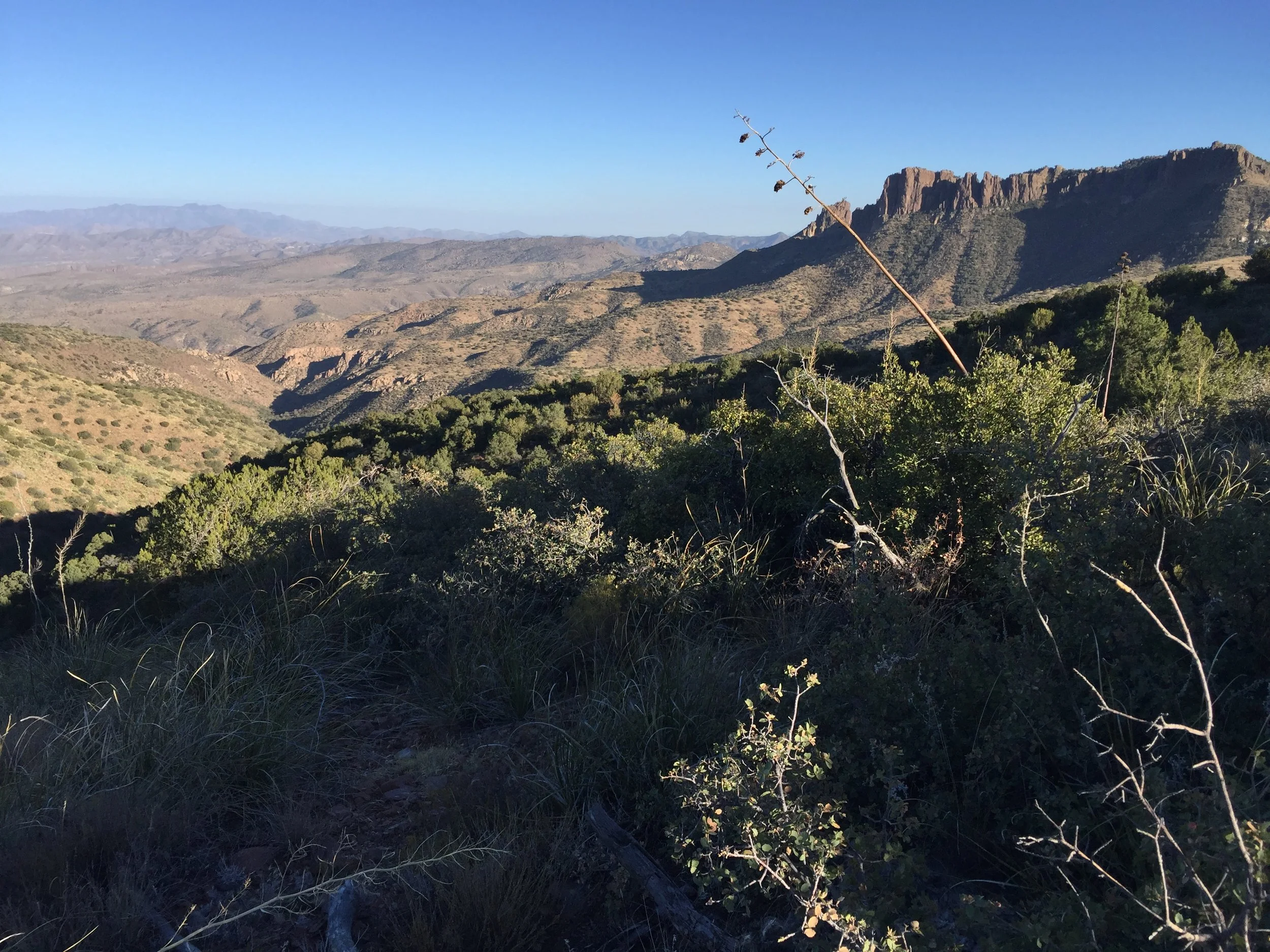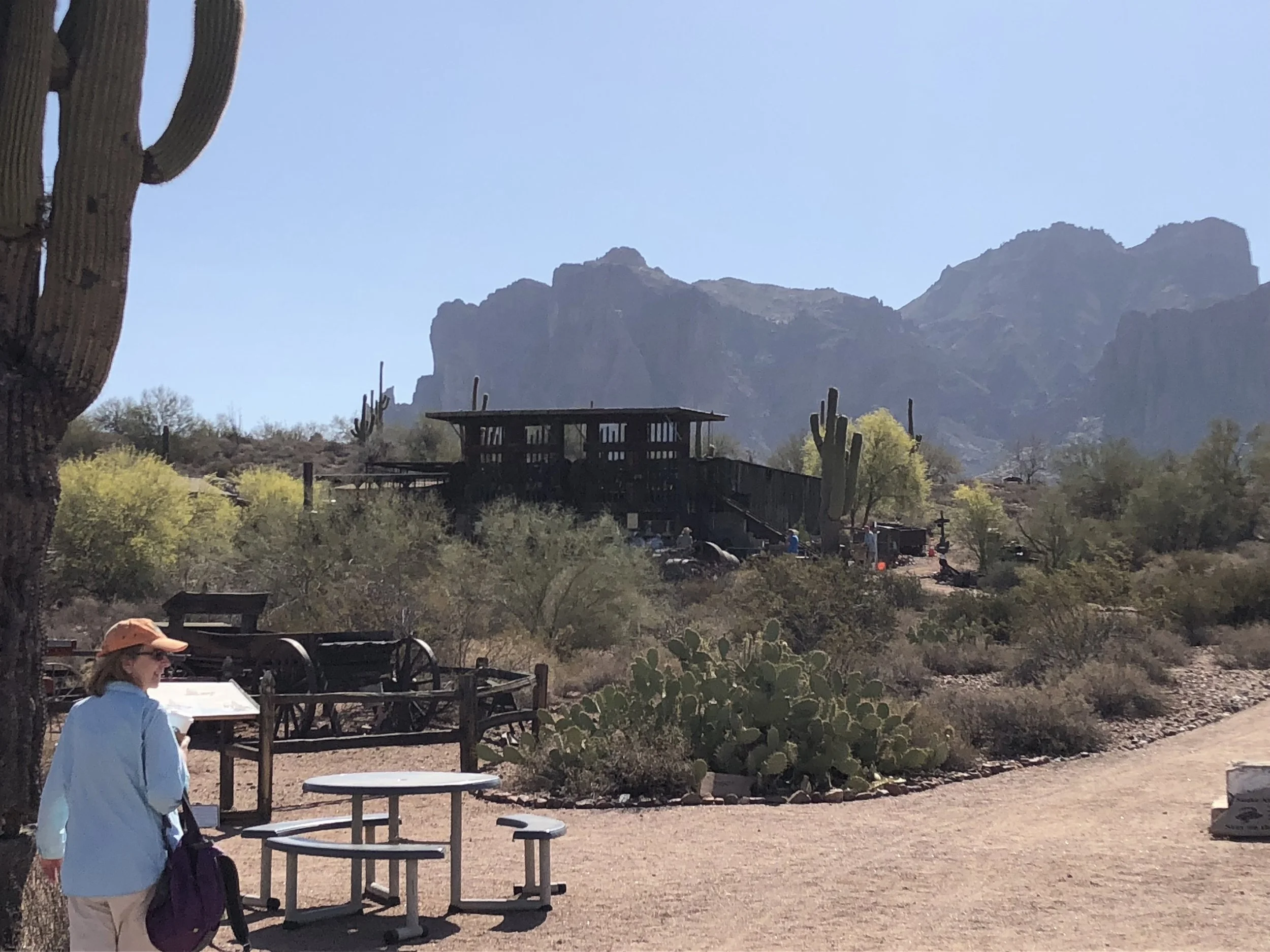The Lost Dutchman Mine: Known Deposits and Direct Evidence of Mineralization in and around the Superstitions
The best known mineral deposits, nearest to the Superstitions, are the epithermal veins of the Goldfields-Youngberg District, located directly west of the western front of the range and the Reymert District, located a few miles south of the range, across US 60, W of Superior. The porphyry copper-related Pioneer (Superior) and the Globe-Miami Districts, are to the SE and E, respectively, of the Superstitions. There are also minor mineral occurrences in the Superstitions proper. We'll look at each of these in turn and evaluate them as possible sources of the Dutchman's gold.
Goldfields-Youngberg: Also known as the Superstition Mining district, this area along AZ SR 88, just NE of Apache Junction, was discovered in 1893, though there are reports of earlier prospects (e.g. the Palmer mine: 1886) and workings there. It is estimated to have produced 5,000 oz of Au, 4,000 oz of Ag and 16,000 lbs of Cu from 23,000 t of ore taken from high-grade veins hosted in Whitetail Conglomerate and Precambrian Ruin Granite. Patchy remnants of Tertiary volcanic rocks are present in the district, becoming more continuous and thicker to the north. The veins strike N-S, dip westerly and were very narrow. Andesitic and biotite quartz monzonite or biotite dacite dikes are reported in the same structures as the veins. Gangue consisted of rather coarse grained drusy quartz and black Mn-calcite. Metallic minerals were earthy hematite, manganese oxides and secondary copper minerals (e.g. chrysacolla) as well as the Au-Ag alloy, electrum. Pyrite, chalcopyrite and galena were encountered at depth.
Figure 1. N end of Superstitions, Goldfields District.
Given the evidence for discovery of the Goldfields deposits much earlier than the official date of 1893 (see Kollenborn, 2004) and, most importantly, earlier than Waltz's death in 1891, as well as their gold-rich and high-grade nature, there is a very good possibility that they could have been the source of the his gold. Many authors have reached this conclusion.
Reymert: The Reymert mine consists of a 2(+) mile long N-S striking, easterly dipping epithermal silver vein. It is hosted in Precambrian Pinal Schist, but is clearly related to a felsic dike that is hosted in the same structure as the vein. Gangue mineralogy consists of black calcite, fluorite, chalcedonic quartz and barite. It was discovered in 1885 and worked till 1950, producing 2.5 Moz of silver. Galena is the only metallic sulfide reported, and no gold was produced from the district. Mineralization with classical epithermal textures both crosscuts and is cut by the felsic dike, which is undoubtedly bracketed by the 20-15 Ma age of the regional volcanic rocks. Wall rock alteration consists of weak hematitization, sericitization and argillization.
The lack of gold in the Reymert vein knocks it out of the running as a possible source of the Dutchman's gold.
Superior (Pioneer): The first claims in the Pioneer District were recorded in 1875. The largest historical deposit was the Magma vein, which was one of the premier copper and gold producers in Arizona, until its closure in the 1996. Total production is estimated at 27.6 million short tons of ore averaging about 4.9% copper, with recovery of 1,299,718 short tons of copper, 36,550 short tons of zinc, approximately 686,000 ounces of gold and 34.3 million ounces of silver. In 1994, a drilling campaign from the deep, eastern levels of the Magma mine, exploring for additional high-grade Cu-Au veins, fortuitously discovered one of the largest, highest-grade porphyry Cu deposits in the US. This blind deposit, originally called Deep Superior, then re-baptized as Resolution, is currently under advanced exploration by a joint venture between Rio Tinto and BHP. It is concealed by younger rocks, including the 18.5 Ma Apache Leap Tuff, which was erupted from the Superstitions.
As noted above, the Magma mine was a significant gold producer, and anomalous gold values are common in the smaller deposits and prospects of the Superior District. The northernmost major mine in the district was the Silver King mine, discovered in 1875. It produced 6.2 Moz of Ag. Gold production was not recorded, so there probably wasn't much.
There is documentary evidence of Waltz having a claim in the Pioneer district, and there are decent gold values in many of the prospects and mines there, so this is on the list as a possible source, although visible gold was rarely found in the district.
Globe-Miami: Globe-Miami is a classic porphyry copper district, however the original claims in the district, staked in 1870, were for silver. Disseminated and stockworks-veinlet copper deposits (first supergene chalcocite, later primary sulfides) were later recognized and became the mainstay of production. Copper occurs in several areas on the northern side of the large Laramide Schultz Granite, where porphyritic apophyses of the latter intrude Precambrain Pinal Schist and diabase. The major deposits are (from west to east): Carlotta, Pinto Valley (formerly known as Castle Dome), Miami and Copper Cities. Mineralization extends NE into the Globe Hills from Miami as specularite-copper veins, the most productive of which was the Old Dominion, which produced over 100,000 oz of Au, in addition to Cu, Pb, Zn and Ag.
Outside of the Old Dominion mine in the Globe Hills, very little gold has ever been produced from the Globe-Miami district which, together with its distance from Waltz's base in Phoenix, places it out of contention for a source of Waltz's gold.
Superstition Mountains (proper): While there never has been any significant mineral production, the largest concentration of minor prospects in the Superstitions are in the JF Ranch, Peralta Canyon and Palmer Mine areas.
The JF Ranch area is located to the W and SW of Roger's Trough and is accessible via the Hewitt Canyon road. Values from sampling by the USBM during wilderness-related studies are anomalous in Ag-Pb-Zn-Cu, but show little or no Au.
The most interesting mineralization in the Peralta Canyon area is in the Dacite Cliffs. USBM assays of quartz-calcite-Cu oxide vein material show Cu, Pb, Ag and minor Au.
The Palmer mine, located between Goldfields and the western escarpment of the Superstitions, was developed on a narrow (2-14 in) silicified zone within a 50 ft wide breccia body in dacite. Limonite and Cu oxides are present as well. The highest grade gold sample from the USBM study came from the Palmer mine and it assayed 0.8 oz/t Au, 0.1oz/t Ag and 4.1% Cu, with 0.025% W. This mine was formerly known as the Boulder-Buckhorn mine, and was originally located in 1886, well before Waltz’s death in 1891.
The Palmer mine, as well as the adjacent Goldfields-Youngberg District, could very well have been the location of Waltz's lost mine. None of the other small mines or prospects known in the Superstitions, that were sampled by the USBM during their evaluation of mineral resources in the Wilderness Study Area, returned more than traces of gold in assayed samples.
Mine and Prospect Locations: There are two other important data sources available from the USGS, to wit: they have compiled all mine and prospect symbols from historical topographic maps and they also maintain a database of mines and prospects with limited but useful information on commodities produced and geology, known as the MRDS (Mineral Resource Data System). The distribution of mines and prospects with Au as the principal commodity tends to corroborate the observations above that the Goldfields/Youngberg District (including the Palmer Mine) is the most likely source of the Dutchman's gold in the Superstitions.
.



